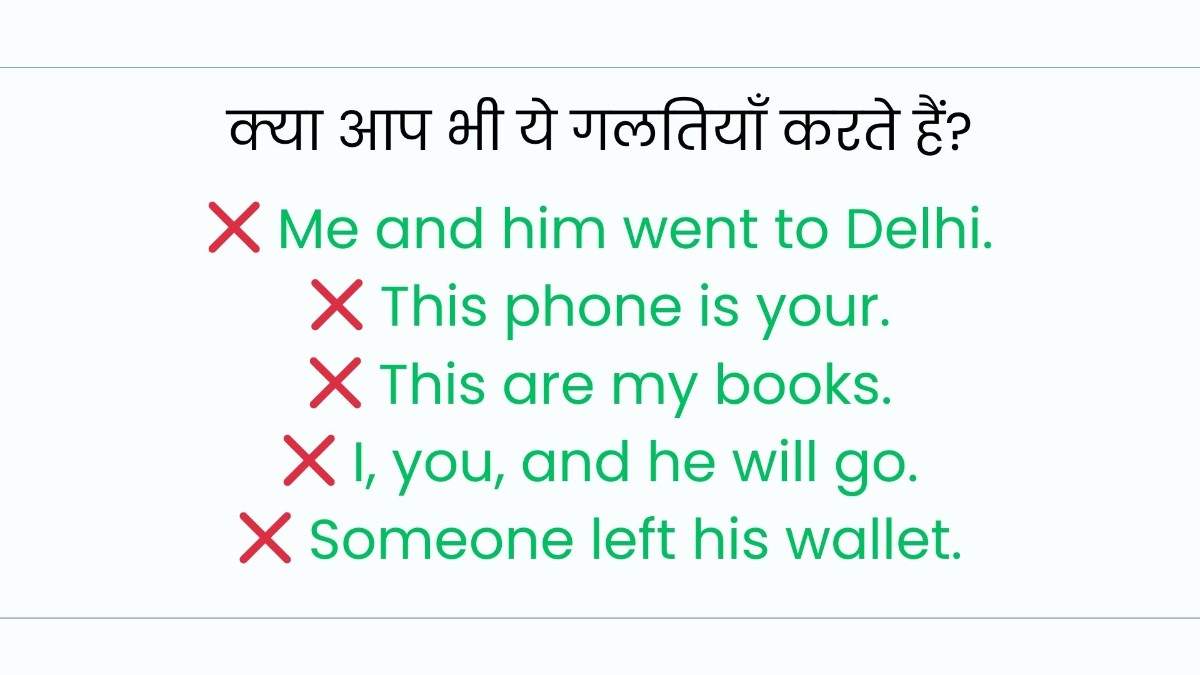Pronoun क्या होता है? (Definition)
A pronoun (सर्वनाम) replaces a noun (संज्ञा) to avoid repetition.
Example:
- Without Pronoun: “Rahul is tired. Rahul is sleeping.”
- With Pronoun: “Rahul is tired. He is sleeping.” / “राहुल थका हुआ है। वह सो रहा है।”
Types of Pronouns (सर्वनाम के प्रकार)
1. Personal Pronouns (व्यक्तिवाचक सर्वनाम)
Replace people/things.
Examples:
I, you, he, she, it / मैं, तुम, वह (पुल्लिंग), वह (स्त्रीलिंग), यह
Sentences:
- She dances well. / वह अच्छा नृत्य करती है।
- They are students. / वे छात्र हैं।
Table: Personal Pronouns
| Person | Subject | Object | Hindi (Subject/Object) |
|---|---|---|---|
| First | I | me | मैं / मुझे |
| Second | you | you | तुम / तुम्हें |
| Third | he | him | वह / उसे |
2. Possessive Pronouns (अधिकारवाचक सर्वनाम)
Show ownership (no noun after them).
Examples:
mine, yours, hers / मेरा, तुम्हारा, उसका
Sentences:
- This book is mine. / यह किताब मेरी है।
- That car is hers. / वह कार उसकी है।
3. Demonstrative Pronouns (संकेतवाचक सर्वनाम)
Point to specific things.
Examples:
this, that, these / यह, वह, ये
Sentences:
- This is my house. / यह मेरा घर है।
- Those are apples. / वे सेब हैं।
4. Reflexive Pronouns (निजवाचक सर्वनाम)
Action reflects back on the subject.
Examples:
myself, yourself, herself / खुद, अपने आप, स्वयं
Sentences:
- She hurt herself. / उसने खुद को चोट पहुँचाई।
- Do it yourself. / इसे अपने आप करो।
Ask questions.
Examples:
who, which, what / कौन, कौन सा, क्या
Sentences:
- Who is there? / कौन है वहाँ?
- What is this? / यह क्या है?
Pronoun Rules (नियम)
1. Subject vs. Object Pronouns
- Subject: “She sings.” / “वह गाती है।”
- Object: “I know her.” / “मैं उसे जानता हूँ।”
2. Gender Agreement
- Masculine: “He is a doctor.” / “वह डॉक्टर है।”
- Feminine: “She is a teacher.” / “वह शिक्षिका है।”
3. Singular/Plural Forms
- Singular: “It is a cat.” / “यह बिल्ली है।”
- Plural: “They are cats.” / “वे बिल्लियाँ हैं।”
4. Pronoun Order in Sentences
1. Standard Polite Order (सामान्य विनम्र क्रम)
Rule: You → He/She/They → I
(तुम → वह/वे → मैं)
Examples:
- “You, he, and I should team up.”
“तुम, वह और मैं टीम बनाएँगे। - “You and I need to talk.”
“तुम और मैं को बात करनी है।
2. With Names (नाम जोड़ने पर)
Rule: Name → You → He/She → I
(नाम → तुम → वह → मैं)
Examples:
- “Riya, you, and I will present.”
“रिया, तुम और मैं प्रेजेंट करेंगे। - “Raj, she, and I are friends.”
“राज, वह और मैं दोस्त हैं।
3. Formal/Honorific Context (औपचारिक स्थितियाँ)
Rule: Title → You → He/She → I
(सम्मान → आप → वह → मैं)
Examples:
- “Sir, you, and he must decide.”
“सर, आप और वह फैसला करें। - “Mom, you, and I will cook.”
“माँ, तुम और मैं खाना बनाएँगे।
4. Admitting Mistakes (गलती स्वीकारना)
Rule: I → You → He/She
(मैं → तुम → वह)
Examples:
- “I, you, and he caused this.”
“मैं, तुम और उसने यह गलती की।
Common Mistakes (गलतियाँ)
1. Subject vs. Object Confusion
❌ “Me and him went to Delhi.”
✅ “He and I went to Delhi.”
(Use subject pronouns – I/he/she – as sentence starters)
2. Possessive Pronoun Errors
❌ “This phone is your.”
✅ “This phone is yours.”
(Possessive pronouns don’t need nouns after them: yours/hers/ours)
3. Reflexive Pronoun Misuse
❌ “She dressed her quickly.”
✅ “She dressed herself quickly.”
(Use -self/-selves when subject & object are same)
4. Gender Agreement Fail
❌ “Every student must submit his homework.” (If class has girls too)
✅ “Every student must submit their homework.”
(Use “they” for gender-neutral singular)
5. Demonstrative Pronoun Mix-Up
❌ “This are my books.”
✅ “These are my books.”
(Match singular/plural: this→is, these→are)
6. Wrong Pronoun Order
❌ “I, you, and they will go.”
✅ “You, they, and I will go.”
(Polite order: You → Others → I)
7. “It” for People
❌ “It is my sister.”
✅ “She is my sister.”
(Never use “it” for humans)
8. Double Subject Error
❌ “My brother he is tall.”
✅ “My brother is tall.”
(Don’t repeat the subject with pronoun)
9. Who/Whom Confusion
❌ “Whom is coming?”
✅ “Who is coming?”
(Use “who” for subjects, “whom” for objects)
10. “They” as Singular
❌ “Someone left his wallet.” (Assumes gender)
✅ “Someone left their wallet.”
(Modern English accepts singular “they”)
Next Steps (आगे क्या करें?):
- Daily Practice: Books, movies, conversations में pronouns पहचानें।
- Self-Test: Quizzes solve करें या sentences rewrite करें।
- Confidence: Native speakers भी mistakes करते हैं — घबराएं नहीं!
Final Thoughts: Pronouns को मास्टर करने का आसान तरीका!
Pronouns (सर्वनाम) English grammar के unsung heroes हैं — ये वाक्यों को smooth, clear और natural बनाते हैं। Hindi speakers के लिए rules थोड़े confusing लग सकते हैं, लेकिन थोड़ी practice और attention से आप common mistakes से बच सकते हैं।
“Grammar strict rules नहीं, बल्कि clear communication का tool है। Pronouns मास्टर करो, और आपकी English naturally flow करेगी!”
